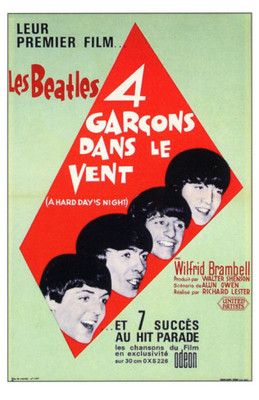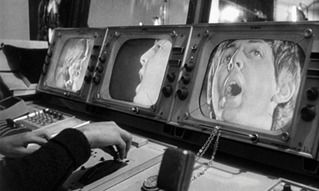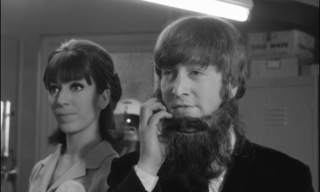
I am amused that the title, in French, is "Four Boys in the Wind."
A Hard Day’s Night
1964
Director: Richard Lester
Starring: John Lennon, Paul McCartney, George Harrison, Ringo Starr, Wilfrid Brambell
Perhaps initially popularized by Elvis and propagated in this day and age by such fine cinematic fare as Justin Bieber: Never Say Never, Hannah Montana: The Movie, and Katy Perry: Part of Me, the movie industry has never shied away from capitalizing on the hot pop music act of the day. These films tend not to make for incredibly profound viewing, and A Hard Day’s Night is no exception. However, it does benefit from having Beatles’ music in it (while not exactly a devotee, I enjoy their stuff) along with some fantastic lines of dialogue.
The plot, such as it is, focuses on the Lads from Liverpool getting to and preparing for a televised gig. At the beginning, they pick up Paul’s grandfather (Brambell) – no, his other grandfather, not the one that lives with him at home – and let him tag along. Problem is, granddad likes to run amok, so keeping tabs on him keeps the boys on their toes. Numerous musical numbers pop up along the way.
The main impression I got when I watched this the first time (about four years ago) was that of total and utter incoherence. Oh, you were looking for a plot that actually developed from point A to point B? I’m sorry, you clearly looked in the wrong place. In terms of cogency, A Hard Day’s Night falls somewhere between an episode of Monty Python’s Flying Circus and El Topo. All of which is to say, the film feels as if it’s barely held together at the seams, as if it’s about to careen over a cliff. The first time I saw this, the lack of logic rather bothered me, and it was all I focused on. I admit I left with a slightly bitter taste in my mouth.

After rewatching it today, I was prepared for this. I didn’t seem to mind it as much. I just accepted that the film would be akin to a Pixie Stix-addict three-year-old bouncing off the walls, and letting go like that allowed the loopy humor to really shine. The one-liners are flung around fast and furious; they have to be, in lieu of any other important dialogue. The lines are definitely funny. Try not snorting at the Beatles’ retorts to reporters, such as, “What do you call the hairstyle you’re wearing?” “Arthur.” Or snipping a tailor’s measuring tape while quipping, “I now declare this bridge open.” It’s eminently quotable, and those that truly love this movie seem to really latch on to the one-liners. In a way, this certainly makes the film rather Pythonesque (and yes, I know that this predates the Python boys); Monty Python fans (self included) have a penchant for quoting favorite lines. In addition to the crazy goofy lines, there’s a fair amount of visual and physical humor thrown in for good measure.
Out of all the Beatles, I found John Lennon to be incredibly enjoyable. The image that Lennon cultivated, the one that persists to this day, is that of a very serious artist doing serious things and seriously interested in saving the world alongside his serious wife Yoko. So to see a John Lennon pretending to snort Coke – a bottle of Coca-Cola, that is – then saying things like “How did you find America?” “Turned left at Greenland,” it’s almost disconcerting. This is not the John Lennon that endures. This is a Puck-like John Lennon, interested in causing as much mayhem as he can get away with. While this particular John Lennon may have been entirely a written character and one that did not exist in real life, it’s still fun to see the real John Lennon play at being a goofy kid. It’s nice to know that he was able to laugh and giggle at some point in his life.

The camerawork, surprisingly enough, is full-on French New Wave. There are jump cuts, speeded up sequences, quick zooms, interesting play with reflections, and plenty of handheld work. I say it’s surprising because this sort of style of filmmaking had yet catch on in Hollywood (it would be another four years or so). If I had to guess, this is probably the first time American audiences saw such a style. It’s easy to take this for granted; we’re so used to such techniques nowadays, but I have to force myself to remember that in 1964, this film looked very novel.
All of this is not to say that I’m a total A Hard Day’s Night convert. I still think it suffers from being, ostensibly, a string of music videos with skit fillers in between. For me, this does not a great film make. It’s a moderately enjoyable way to pass an hour and a half, sure, but it’s incredibly goofy and lacks any sense of coherency. To those seeing it for the first time, be prepared to have no idea what the eff is going on.
Arbitrary Rating: 7/10
I think it's safe to say that if A Hard Day's Night never existed, neither would the early days of MTV.
ReplyDeleteAs a huge Beatles fan, I'm geared to enjoy this film for what it is, but beyond that, it's still hard to downplay its influence. You're right about Lennon, too. He's having fun here rather than being serious all the time about weighty issues.
My favorite part, though, is George in the television executive's office. "Oh, by all means. I'd be quite prepared for that eventuality."
Yes, this flick definitely proved there was an audience for filmed musical mayhem, enough so to power an entire cable network.
DeleteGeorge in the office was really funny, I definitely enjoyed that part. The physical humor with Ringo in the pub was good too. Lennon was the biggest surprise, though!